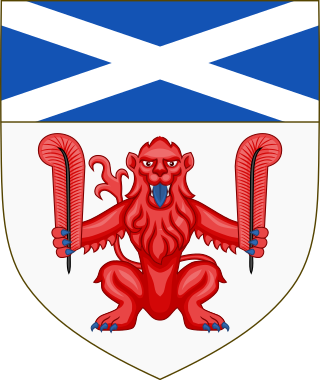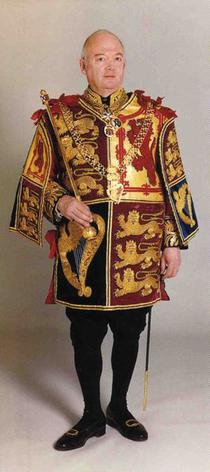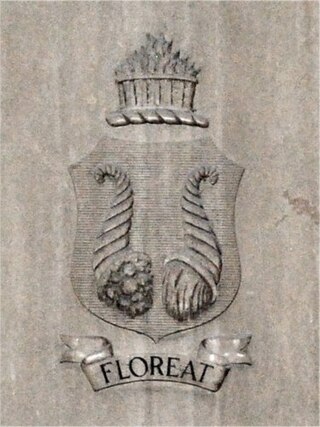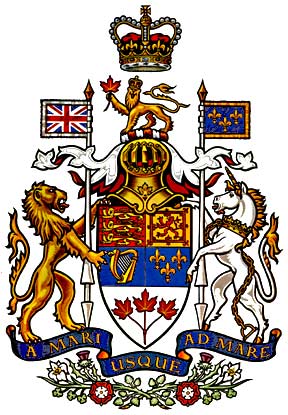Related Research Articles

The Genealogical Office is an office of the Government of Ireland containing genealogical records. It includes the Office of the Chief Herald of Ireland, the authority in Ireland for heraldry. The Chief Herald authorises the granting of arms to Irish bodies and Irish people, including descendants of emigrants. The office was constituted on 1 April 1943 as successor to the Ulster King of Arms, established during the Tudor period of the Kingdom of Ireland in 1552. The Ulster King of Arms' duties in relation to Northern Ireland were taken over by the Norroy and Ulster King of Arms.

The governor of Queensland is the representative in the state of Queensland of the monarch, currently King Charles III. In an analogous way to the governor-general at the national level, the governor performs constitutional and ceremonial functions at the state level. In particular the governor has the power to appoint and dismiss the premier of Queensland and all other ministers in the Cabinet, and issue writs for the election of the state parliament.

The College of Arms, or Heralds' College, is a royal corporation consisting of professional officers of arms, with jurisdiction over England, Wales, Northern Ireland and some Commonwealth realms. The heralds are appointed by the British Sovereign and are delegated authority to act on behalf of the Crown in all matters of heraldry, the granting of new coats of arms, genealogical research and the recording of pedigrees. The College is also the official body responsible for matters relating to the flying of flags on land, and it maintains the official registers of flags and other national symbols. Though a part of the Royal Household of the United Kingdom, the College is self-financed, unsupported by any public funds.

The coat of arms of Queensland is one of the formal symbols of the Australian state of Queensland and represents the King's constitutional authority throughout the state. It is the oldest of the state arms of Australia, having been granted in 1893 by Queen Victoria, through the simplest heraldic grants of only the shield of arms, motto, helmet, mantling and crest. In 1977, the red deer and the brolga were assigned as supporters by Queen Elizabeth II during her Silver Jubilee.

The Bureau of Heraldry is the South African heraldic authority, established in Pretoria on 1 June 1963. It is headed by a State Herald and its functions are to register arms, badges, flags and seals, to keep a public register, to issue registration certificates and, since 1980, to advise the government on heraldic matters. Together with the Heraldry Council, it forms part of the National Archives and Records Service, which is currently under the authority of the Minister of Sports, Arts and Culture.

The Canadian Heraldic Authority is part of the Canadian honours system under the Canadian monarch, whose authority is exercised by the Governor General of Canada. The authority is responsible for the creation and granting of new coats of arms, flags, and badges for Canadian citizens, government agencies, municipal, civic and other corporate bodies. The authority also registers existing armorial bearings granted by other recognized heraldic authorities, approves military badges, flags, and other insignia of the Canadian Forces, and provides information on heraldic practices. It is well known for its innovative designs, many incorporating First Nations symbolism.

New Zealand Herald of Arms Extraordinary is an officer of arms representing the heraldic interests of New Zealand. Although affiliated with the College of Arms in London, the New Zealand Herald lives and works in New Zealand, and is not a member of the College Chapter. Since the New Zealand Herald was appointed, there have been questions as to his legitimacy and whether, as working under the authority of the College of Arms, he has any legal authority to regulate heraldry in New Zealand. The current New Zealand Herald of Arms Extraordinary is Phillip O'Shea.

The law of heraldic arms, sometimes simply laws of heraldry governs the possession, use or display of arms, called bearing of arms. That use includes the coats of arms, coat armour or armorial bearings. Originally with the sole function of enabling knights to identify each other on the battlefield, they soon acquired wider, more decorative uses. Today they are used by countries, public and private institutions or individuals. The first laws regarding arms were written by Bartolus de Saxoferrato and the officials who administer these matters today are called pursuivants, heralds, or kings of arms. The law of arms is part of the law in countries which regulate heraldry, although not part of common law in England and in countries whose laws derive from English law. In most European countries without monarchies, much like in the United States, there are no laws against assuming arms, with the closest legal authenticity mechanism being a pictorial copyright protection.

Heraldry in Scotland, while broadly similar to that practised in England and elsewhere in western Europe, has its own distinctive features. Its heraldic executive is separate from that of the rest of the United Kingdom.

Lyon Clerk and Keeper of the Records is a legal and heraldic office in Scotland. The holder of this office is appointed by the Crown, and like the Lord Lyon King of Arms receives an annual salary. Lyon Clerk's duties include heraldic research, the preparation of papers, lectures and conducting and assisting with the preliminary business of application for a grant or matriculation of armorial bearings. This includes scrutiny of documents supporting the application. As Keeper of the Records the duties include maintaining the records of the Court of the Lord Lyon, overseeing the preparation of documents, allowing inspection of the Public Register of All Arms and Bearings in Scotland and other records, and issuing certified extracts when required. Until 1867 there was a Lyon Clerk Depute, and in 1986 Elizabeth Ann Roads became the first woman appointed to the office of Lyon Clerk and Keeper of the Records.

John Philip Brooke Brooke-Little was an English writer on heraldic subjects, and a long-serving herald at the College of Arms in London. In 1947, while still a student, Brooke-Little founded the Society of Heraldic Antiquaries, now known as the Heraldry Society and recognised as one of the leading learned societies in its field. He served as the society's chairman for 50 years and then as its president from 1997 until his death in 2006.
The Office of the Controller General of Patents, Designs and Trade Marks(CGPDTM) generally known as the Indian Patent Office, is an agency under the Department for Promotion of Industry and Internal Trade which administers the Indian law of Patents, Designs and Trade Marks.

A grant of arms or a governmental issuance of arms is an instrument issued by a lawful authority, such as an officer of arms or State Herald, which confers on a person and his or her descendants the right to bear a particular coat of arms or armorial bearings. It is one of the ways in which a person may lawfully bear arms in a jurisdiction regulating heraldry, another being by birth, through inheritance.

South African heraldry dates back to the 1650s, inheriting European heraldic traditions. Arms are borne by individuals, official bodies, local authorities, military units, and by a wide variety of organisations. South Africa has had its own heraldic authority since 1963, to provide armigers with legal protection, and to promote high standards of armorial practice.
Irish heraldry is the forms of heraldry, such as coats of arms, in Ireland. Since 1 April 1943 it is regulated in the Republic of Ireland by the Office of the Chief Herald of Ireland and in Northern Ireland by Norroy and Ulster King of Arms. Prior to that, heraldry on the whole island of Ireland was a function of the Ulster King of Arms, a crown office dating from 1552. Despite its name the Ulster King of Arms was based in Dublin.

Canadian heraldry is the cultural tradition and style of coats of arms and other heraldic achievements in both modern and historic Canada. It includes national, provincial, and civic arms, noble and personal arms, ecclesiastical heraldry, heraldic displays as corporate logos, and Canadian blazonry.
Maltese heraldry is the design, display, and study of armorial bearings as used in the traditions of Malta.
A heraldic authority is defined as an office or institution which has been established by a reigning monarch or a government to deal with heraldry in the country concerned. It does not include private societies or enterprises which design and/or register coats of arms. Over the centuries, many countries have established heraldic authorities, and several still flourish today.

The Court of the Lord Lyon, or Lyon Court, is a standing court of law, based in New Register House in Edinburgh, which regulates heraldry in Scotland. The Lyon Court maintains the register of grants of arms, known as the Public Register of All Arms and Bearings in Scotland, as well as records of genealogies.

Letters patent, in the United Kingdom, are legal instruments generally issued by the monarch granting an office, right, title, or status to a person. Letters patent have also been used for the creation of corporations or offices, for granting city status, for granting coat of arms, and for granting royal assent.
References
- ↑ Malta Government Gazette 18832 dated 25 June 2019.
- ↑ Ombudsman's Report U 0059 dated 21 July 2021.
- ↑ "A Heraldry Addict's Weblog".
- ↑ Cultural Heritage (Amendment) Act 2021.
- 1 2 3 Heraldry and Genealogy Regulations 2021 in Malta Government Gazette 20758 dated 28 December 2021.
- ↑ Malta Government Gazette 20842 dated 22 April 2022.